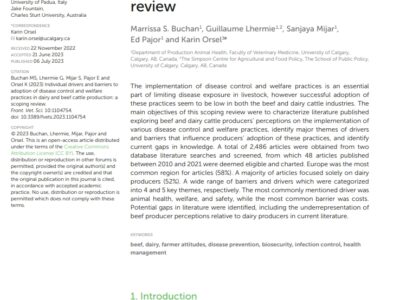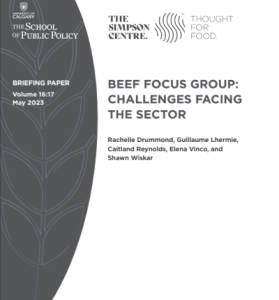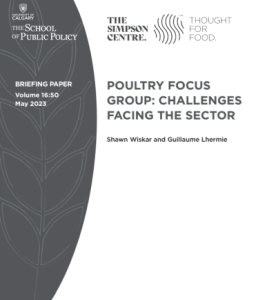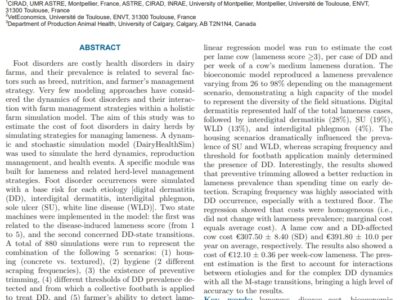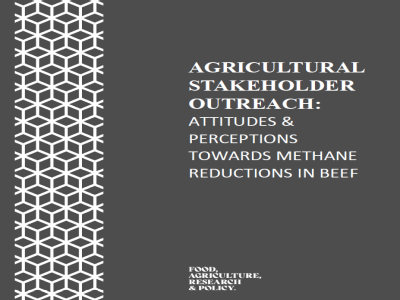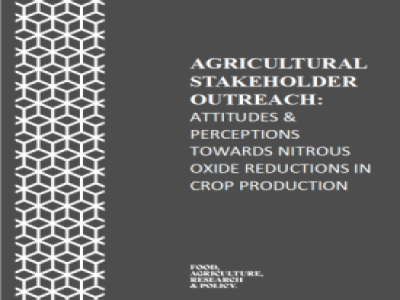Publications
The implementation of disease control and welfare practices is an essential part of limiting disease exposure in livestock, however successful adoption of these practices seem to be low in both the beef and dairy cattle industries. The main objectives of this scoping review were to characterize literature published exploring beef and dairy cattle producers’ perceptions on the implementation of various disease control and welfare practices, identify major themes of drivers and barriers that influence producers’ adoption of these practices, and identify current gaps in knowledge. A total of 2,486 articles were obtained from two database literature searches and screened, from which 48 articles published between 2010 and 2021 were deemed eligible and charted. Europe was the most common region for articles (58%). A majority of articles focused solely on dairy producers (52%). A wide range of barriers and drivers which were categorized into 4 and 5 key themes, respectively. The most commonly mentioned driver was animal health, welfare, and safety, while the most common barrier was costs. Potential gaps in literature were identified, including the underrepresentation of beef producer perceptions relative to dairy producers in current literature.
Thursday, July 06, 2023
Marrissa S. Buchan, Guillaume Lhermie, Sanjaya Mijar, Ed Pajor, and Karin Orsel
The Simpson Centre ran a focus group in July 2022 to better understand how the Canadian
cattle industry is handling various challenges, how they interact with policy and their
short-term and long-term priorities. The focus group was made up of industry stakeholders
from various points throughout the supply chain. The discussions were recorded and then
analyzed and coded to determine the key points and develop policy recommendations.
Friday, May 26, 2023
Rachelle Drummond, Guillaume Lhermie, Caitland Reynolds, Elena Vinco, and Shawn Wiskar
The Canadian poultry industry is small but significant; chicken is the most consumed animal meat protein in the country, the consumption of which has increased with population growth and immigration from cultures that favour the meat over beef and pork. Meanwhile, the industry is under pressure to align with sustainability goals, specifically to reduce its greenhouse gas emissions. In 2021, to better understand the industry’s challenges and possible policy solutions to those challenges, the Simpson Centre assembled a focus group of industry stakeholders to discuss their opinions regarding the challenges facing Canadian poultry sector, along with how the sector interacts with policy, and their short-term and long-term priorities.
Thursday, May 11, 2023
Shawn Wiskar and Guillaume Lhermie
Foot disorders are costly health disorders in dairy farms, and their prevalence is related to several factors such as breed, nutrition, and farmer’s management strategy. Very few modeling approaches have considered the dynamics of foot disorders and their interaction with farm management strategies within a holistic farm simulation model. The aim of this study was to estimate the cost of foot disorders in dairy herds by simulating strategies for managing lameness. A dynamic and stochastic simulation model (DairyHealthSim) was used to simulate the herd dynamics, reproduction management, and health events. A specific module was built for lameness and related herd-level management strategies. Foot disorder occurrences were simulated with a base risk for each etiology [digital dermatitis (DD), interdigital dermatitis, interdigital phlegmon, sole ulcer (SU), white line disease (WLD)]. Two state machines were implemented in the model: the first was related to the disease induced lameness score (from 1 to 5), and the second concerned DD-state transitions. A total of 880 simulations were run to represent the combination of the following 5 scenarios: (1) housing (concrete vs. textured), (2) hygiene (2 different scraping frequencies), (3) the existence of preventive trimming, (4) different thresholds of DD prevalence detected and from which a collective footbath is applied to treat DD, and (5) farmer’s ability to detect lameness (detection rate). Housing, hygiene, and trimming scenarios were associated with risk factors applied for each foot disorder etiologies. The footbath and lameness detection scenarios both determined the treatment setup and the policy of herd observance. The economic evaluation outcome was the gross margin per year. A linear regression model was run to estimate the cost per lame cow (lameness score ≥3), per case of DD and per week of a cow’s medium lameness duration. The bioeconomic model reproduced a lameness prevalence varying from 26 to 98% depending on the management scenario, demonstrating a high capacity of the model to represent the diversity of the field situations. Digital dermatitis represented half of the total lameness cases, followed by interdigital dermatitis (28%), SU (19%), WLD (13%), and interdigital phlegmon (4%). The housing scenarios dramatically influenced the prevalence of SU and WLD, whereas scraping frequency and threshold for footbath application mainly determined the presence of DD. Interestingly, the results showed that preventive trimming allowed a better reduction in lameness prevalence than spending time on early detection. Scraping frequency was highly associated with DD occurrence, especially with a textured floor. The regression showed that costs were homogeneous (i.e., did not change with lameness prevalence; marginal cost equals average cost). A lame cow and a DD-affected cow cost €307.50 ± 8.40 (SD) and €391.80 ± 10.0 per year on average, respectively. The results also showed a cost of €12.10 ± 0.36 per week-cow lameness. The present estimation is the first to account for interactions between etiologies and for the complex DD dynamics with all the M-stage transitions, bringing a high level of accuracy to the results.
Tuesday, March 07, 2023
Rodolphe Robcis, Ahmed Ferchiou, Mehdi Berrada, Youba Ndiaye, Nicolas Herman, Guillaume Lhermie, and Didier Raboisson
The importance of Canadian beef production in the context of Albertan economics, environment, and identity,
cannot be understated. With the highest percentage of the national beef herd located in Alberta, beef cattle
producers are crucial in the transformation of the sector to ensure sustainable practices that reduce enteric
methane emissions. The Canadian Beef Advisors, consisting of national beef organizations involved in
Canadian beef marketing, policy, research, and sustainability, announced Canada’s National Beef Strategy in 2015. The strategy aims to ensure Canadian beef production practices adapt to changes in markets across
sustainability and environmental dimensions, with a target to reduce primary production GHG emission
intensity by 33 percent by 2030. This goal aligns with current Agricultural and Agri-Food Canada’s research on
methane emission reductions and offers critical perspective on the role of beef cattle production in ecosystem services, through carbon sequestration and pasture grazing management. Ultimately, the choice to
implement and adopt practices will depend on the cattle producer at the on-farm level.
Wednesday, January 25, 2023
Elena Vinco, Nicole Morrison, Joshua Bourassa and Guillaume Lhermie
The pressure to change agricultural practices in order to mitigate emissions is high, with persisting
environmental, social, and economic dimensions. In December 2020, the Government of Canada released A
Healthy Environment and a Healthy Economy, a climate plan that proposed Canada’s first national emission
reduction target for the agricultural sector. This target aimed to reduce fertilizer-based emissions by 30
percent of 2020 levels by 2030. This target relies on the adoption of Best Management Practices for fertilizer
use at the on-farm level. Choice to adopt the emission reduction strategies and practices is ultimately decided
by the landowner, operator, and/or producer. The proposed target was met with significant resistance
opposition from producers and producer groups across Canada’s agricultural sector, particularly in western
Canada, with claims that the target was the equivalent to a ban on fertilizer.
Wednesday, January 25, 2023
Elena Vinco, Nicole Morrison, Joshua Bourassa and Guillaume Lhermie

